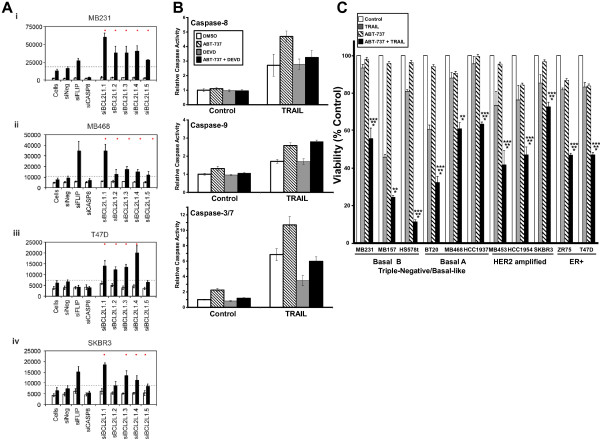Figure 7.

Inhibition of BCL2L1 (BCL-XL) sensitizes breast cancer cells to TRAIL. (A) MB231, MB468, T47D, and SKBR3 cells were incubated with five different targeting siRNAs for 48 hours, and caspase-3/7 activity was assayed 1 hour after addition of 1,000 ng/ml TRAIL. siNeg, siFLIP, and siCasp8 are included in each screen as controls. The grey dashed line represents 1-standard deviation increase in TRAIL-induced caspase-3/7 activation compared with TRAIL-treated cells transfected with the siNeg control. The red dots indicate those siRNAs that induced a fold-change greater than 1 standard deviation. (B) MB231 cells were incubated with TRAIL (1,000 ng/ml), the BCL2 family inhibitor ABT-737 (5 μM), or both in the presence or absence of DEVD-CHO (30 nM). Activation of caspase-8, caspase-9, and caspase-3/7 as measured by Caspase-Glo assays 1 hour after TRAIL addition. Data show the mean activity ± SD for one representative experiment. (C) MTS assay to measure cell viability of different breast cancer cells after pretreatment with or without 5 μM ABT-737 for 1 hour followed by treatment with 8 ng/ml (MB231, Hs578t) or 63 ng/ml (MB157, BT20, MB468, HCC1937, ZR75, T47D), 250 ng/ml (MB453, HCC1954), or 500 ng/ml (SKBR3) of TRAIL for 17 hours. Data shown are the mean ± SEM for three experiments for each cell line, and the data were compared by using a two-tailed Student's t test. *P < 0.05, comparing the combination treatment with TRAIL alone; **P < 0.05 comparing the combination treatment with ABT-737 alone; and ***P < 0.05 comparing the combination treatment with the sum of the inhibition by TRAIL alone plus the inhibitor alone.
